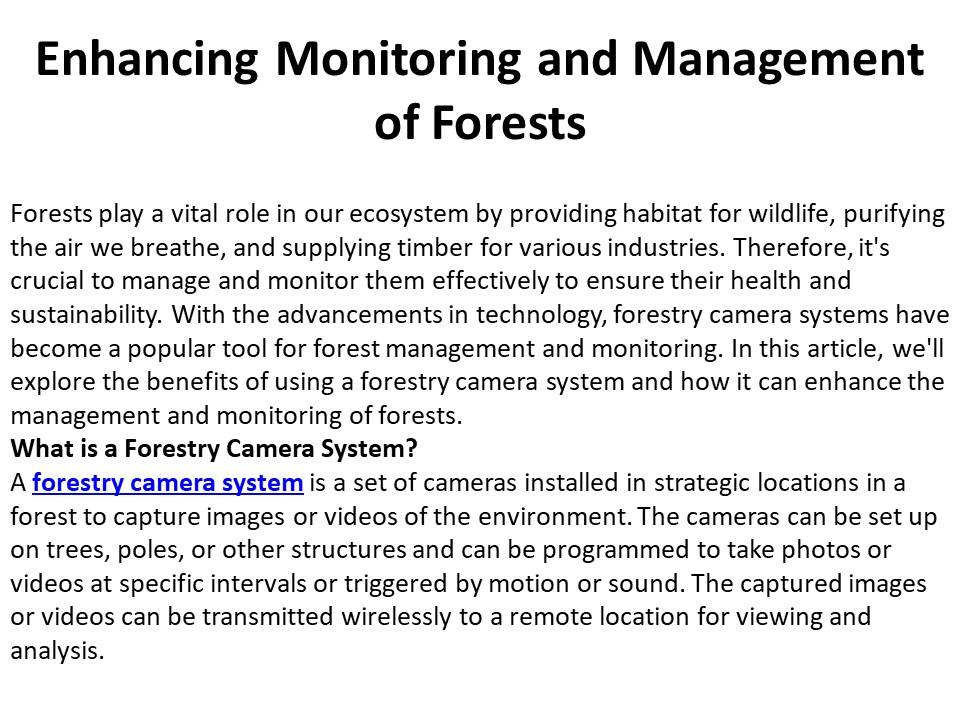Forestry Camera System - PowerPoint PPT Presentation
Title:
Forestry Camera System
Description:
If you are looking to take your logging operations to the next level, depend on Falcon Forestry Equipment to do so. Our heavy-duty and technologically advanced equipment includes Winch Assist, Grapple Claw, HD Grapple Camera, and more. All these are designed to maximize your logging operations while reducing the health and safety risks of the crew. Call now for more information. – PowerPoint PPT presentation
Number of Views:2
Title: Forestry Camera System
1
Enhancing Monitoring and Management of Forests
Forests play a vital role in our ecosystem by
providing habitat for wildlife, purifying the air
we breathe, and supplying timber for various
industries. Therefore, it's crucial to manage and
monitor them effectively to ensure their health
and sustainability. With the advancements in
technology, forestry camera systems have become a
popular tool for forest management and
monitoring. In this article, we'll explore the
benefits of using a forestry camera system and
how it can enhance the management and monitoring
of forests. What is a Forestry Camera
System? A forestry camera system is a set of
cameras installed in strategic locations in a
forest to capture images or videos of the
environment. The cameras can be set up on trees,
poles, or other structures and can be programmed
to take photos or videos at specific intervals or
triggered by motion or sound. The captured images
or videos can be transmitted wirelessly to a
remote location for viewing and analysis.
2
(No Transcript)
3
Benefits of Using a Forestry Camera
System Monitoring Forest Health A forestry
camera system can help monitor the health of a
forest by capturing images of tree growth and
changes in vegetation. This information can be
used to detect potential issues such as disease,
insect infestation, or fire damage, enabling
timely intervention to prevent further
damage. Wildlife Monitoring Forests are home to
a diverse range of wildlife, some of which are
endangered or threatened. Forestry camera systems
can capture images of wildlife movement and
behavior, providing valuable data for
conservation efforts. Forest Management A
forestry camera system can assist in forest
management by monitoring human activities such as
logging, hunting, or illegal activities. The
cameras can also capture images of weather
patterns, helping forest managers to plan and
prepare for weather-related events such as floods
or wildfires. Cost-Effective A forestry camera
system is a cost-effective tool for forest
management and monitoring. The cameras can be
installed in remote locations and programmed to
operate autonomously, reducing the need for
manual monitoring and data collection. Types of
Forestry Camera Systems There are various types
of forestry camera systems available in the
market, and choosing the right one depends on the
specific needs and objectives of the forest
management team. Here are some common types of
forestry camera systems
4
Time-Lapse Cameras Time-lapse cameras capture
images at set intervals, allowing for the
creation of time-lapse videos. They are useful
for monitoring long-term changes in the forest
environment such as seasonal changes. Trail
Cameras Trail cameras are motion-activated
cameras that capture images or videos of wildlife
movement. They are useful for wildlife monitoring
and research. Pan-Tilt-Zoom Cameras
Pan-tilt-zoom cameras can be remotely controlled
to capture images or videos of specific areas of
interest. They are useful for monitoring human
activities and for security purposes. Infrared
Cameras Infrared cameras use infrared technology
to capture images or videos in low light or
nighttime conditions. They are useful for
wildlife monitoring and research. Conclusion Fores
try camera systems are a valuable tool for forest
management and monitoring. They provide critical
data for detecting potential issues, conserving
wildlife, and managing forests effectively. With
the different types of forestry camera systems
available, forest management teams can choose the
one that best suits their specific needs and
objectives. Investing in a forestry camera system
can be a cost-effective way to enhance the health
and sustainability of forests.































